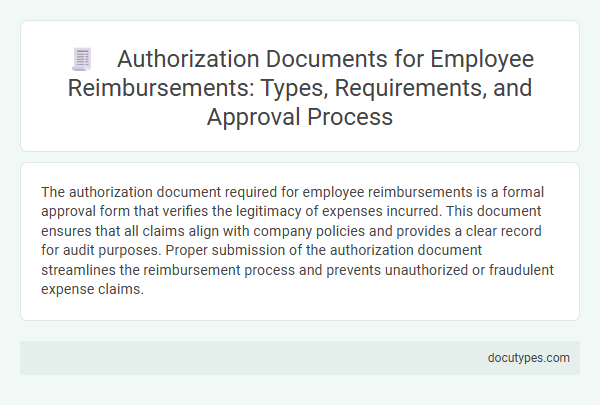The authorization document required for employee reimbursements is a formal approval form that verifies the legitimacy of expenses incurred. This document ensures that all claims align with company policies and provides a clear record for audit purposes. Proper submission of the authorization document streamlines the reimbursement process and prevents unauthorized or fraudulent expense claims.
Introduction to Authorization Documents for Employee Reimbursements
| Topic | Description |
|---|---|
| Authorization Document | A formal written approval required to process employee reimbursements for business expenses. |
| Purpose | Ensures that reimbursement requests are valid, legitimate, and comply with company policies. |
| Key Components | Employee details, expense description, amount, date, approval signatures, and supporting receipts. |
| Importance | Prevents unauthorized or fraudulent claims and maintains accurate financial records. |
| Typical Formats | Paper forms, digital authorization requests, and expense management software entries. |
| Required Approvals | Supervisors, finance department, or designated authority must review and sign off. |
| Compliance | Aligned with internal policies, corporate governance, and legal standards. |
| Benefits | Streamlines reimbursement processing, enhances accountability, and supports audit trails. |
Importance of Authorization in Reimbursement Processes
What is the authorization document required for employee reimbursements? The authorization document serves as official approval confirming that the expenses claimed by employees comply with company policies. It ensures transparency and accountability in the reimbursement processes.
Why is authorization important in employee reimbursement processes? Authorization prevents fraudulent claims and unauthorized spending by requiring managerial or finance department approval before funds are disbursed. This control mechanism safeguards company resources and maintains accurate financial records.
Key Types of Authorization Documents
Authorization documents are essential for controlling and validating employee reimbursements. These documents ensure that expenses meet company policies and approval requirements.
- Expense Approval Form - A formal document submitted by employees detailing the incurred expenses and seeking authorization prior to reimbursement.
- Managerial Approval - Signed or digital consent from a supervisor or authorized personnel validating the legitimacy of the expense claims.
- Receipts and Invoices - Proof of payment documents that verify the expenditure and support reimbursement requests.
Standard Requirements for Reimbursement Authorization
An authorization document for employee reimbursements verifies that expenses comply with company policies. This document ensures proper approval before funds are disbursements.
Standard requirements include employee name, date of expense, description, and amount. Your signature or manager's approval confirms the legitimacy of the claim.
Step-by-Step Approval Process Overview
The authorization document required for employee reimbursements serves as formal approval confirming expenses are legitimate and comply with company policies. It typically includes details such as the employee's name, expense description, amount, date, and supporting receipts. Following a step-by-step approval process ensures accuracy and accountability before funds are disbursed.
The first step involves the employee submitting the reimbursement request with all necessary documentation. Next, the immediate supervisor reviews and approves the expenses to verify they align with budget constraints. Finally, the finance department performs a thorough audit before processing the payment.
You should maintain a clear record of each authorization document to streamline future reimbursements and support audits. Automating the process with digital tools can enhance efficiency and reduce errors. Consistent application of the approval workflow protects the organization from fraudulent or non-compliant claims.
Role of Supervisors and Finance in Authorization
The authorization document required for employee reimbursements serves as official approval verifying that expenses comply with company policies. Supervisors play a critical role in reviewing and endorsing these documents to ensure accuracy and legitimacy. The finance department then validates the authorization before processing the reimbursement, safeguarding financial integrity. You must submit the properly authorized document to avoid delays in payment.
Common Challenges in Reimbursement Authorization
Authorization documents for employee reimbursements are essential to validate expenses and ensure compliance with company policies. These documents typically include detailed information such as approval signatures, expense descriptions, and supporting receipts.
- Incomplete Documentation - Missing receipts or approval signatures can delay the reimbursement process and cause discrepancies.
- Inconsistent Policy Enforcement - Variations in applying reimbursement rules lead to confusion and potential unauthorized claims.
- Delayed Approvals - Slow authorization workflows hinder timely reimbursements and affect employee satisfaction.
Clear and consistent authorization documentation streamlines employee reimbursements and minimizes administrative obstacles.
Best Practices for Documenting Authorization
Authorization documents are essential for verifying employee reimbursement requests, ensuring compliance with company policies. Proper documentation reduces fraud risk and simplifies the audit process.
- Clear Approval Signatures - Authorization documents must include signatures from designated supervisors to validate the reimbursement request.
- Detailed Expense Descriptions - Each reimbursement entry should specify the nature of the expense to justify its business purpose.
- Retention of Original Receipts - Employees should submit original receipts to support the claimed amounts, enabling transparent financial tracking.
Compliance and Audit Considerations
An authorization document required for employee reimbursements serves as official approval confirming the legitimacy of the expenses incurred. This document ensures that reimbursements align with company policies and regulatory standards.
Compliance with internal controls and external regulations is critical to prevent fraud and financial discrepancies. Proper documentation facilitates transparent audit trails, simplifying the verification process during internal and external audits. Maintaining detailed authorization records supports adherence to tax laws and corporate governance requirements.
What Is the Authorization Document Required for Employee Reimbursements? Infographic

